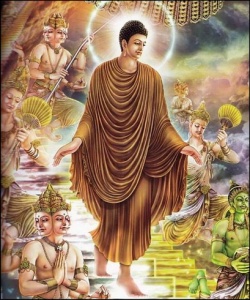Difference between revisions of "Agnidatta"
| Line 1: | Line 1: | ||
[[File:Image022.jpg|thumb|250px|]] | [[File:Image022.jpg|thumb|250px|]] | ||
| + | |||
| + | |||
| + | |||
| + | |||
| + | |||
| + | |||
| + | |||
| + | |||
<poem> | <poem> | ||
[[Agnidatta]] | [[Agnidatta]] | ||
| Line 17: | Line 25: | ||
The [[Buddha]]'s [[Preaching Life Sutra]] and the above treatise describe [[Agnidatta]] as a {{Wiki|Brahman}}, while The Ten Divisions of [[Monastic]] Rules indicates that he was the [[ruler]] of Vairanja and an adherent of {{Wiki|Brahmanism}}. | The [[Buddha]]'s [[Preaching Life Sutra]] and the above treatise describe [[Agnidatta]] as a {{Wiki|Brahman}}, while The Ten Divisions of [[Monastic]] Rules indicates that he was the [[ruler]] of Vairanja and an adherent of {{Wiki|Brahmanism}}. | ||
| + | |||
| + | |||
</poem> | </poem> | ||
{{R}} | {{R}} | ||
Latest revision as of 10:19, 17 April 2024
Agnidatta
阿耆達多・阿耆達・阿耆多 (Skt; Jpn Agidatta, Agitatsu, or Agita)
Also known as Ajita .A Brahman who lived during the time of Shakyamuni.
Agnidatta was a wealthy householder who lived in a district named Vairanjain Kosala, India.
He respected Shakyamuni and invited him to stay at his home for three months.Shakyamuni went to Agnidatta's mansion with his five hundred monk-disciples, but Agnidatta was so completely absorbed in the pursuit of pleasure that he forgot about his invitation and had the gate shut for three months.
It was a time of famine, and Shakyamuni's disciples walked about begging for alms, but in vain.
Finally, a horse groom offered oats meant as horse fodder to Shakyamuni and his disciples, who survived on this alone for a period of three months.
In The Treatise on the Great Perfection of Wisdom, this incident is listed as one of the nine great ordeals that Shakyamuni underwent.
The Buddha's Preaching Life Sutra and the above treatise describe Agnidatta as a Brahman, while The Ten Divisions of Monastic Rules indicates that he was the ruler of Vairanja and an adherent of Brahmanism.
